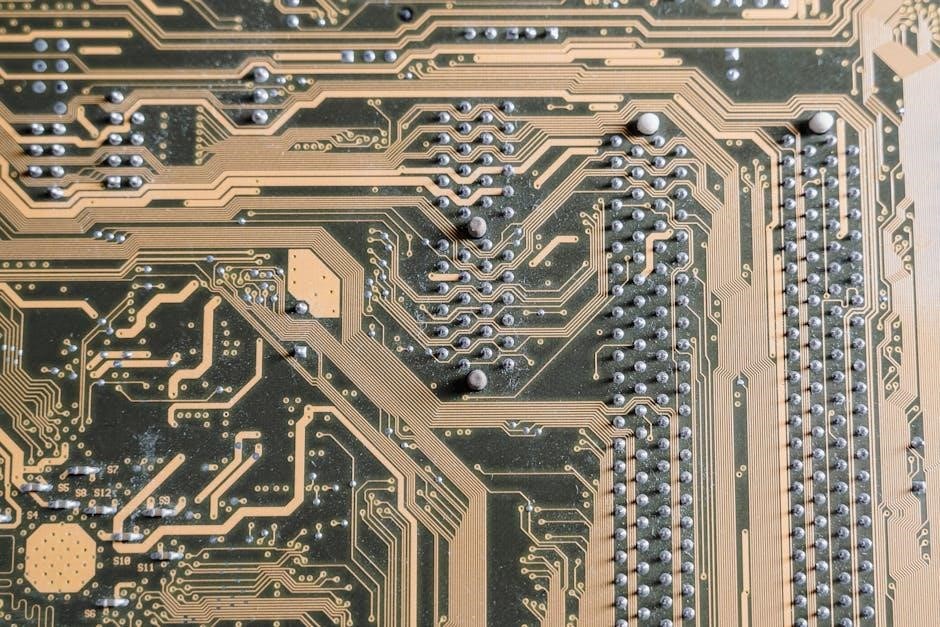7.3 powerstroke wiring diagram pdf

7.3 powerstroke wiring diagram pdf
Welcome to the comprehensive guide for the 7․3 Powerstroke wiring diagram․ This resource is essential for understanding the electrical system, repairs, and modifications․ Explore key components, troubleshooting, and PDF resources for a seamless experience․
Overview of the 7․3 Powerstroke Engine
The 7․3L Powerstroke engine, produced from 1999 to 2003, is a highly reliable diesel engine known for its durability and performance․ It features a direct-injection fuel system, with a turbocharger for enhanced power output․ The engine’s electronic control systems, including the PCM and FICM, manage fuel injection, timing, and emissions․ Its robust design and high torque output make it a favorite among truck enthusiasts․ Common repairs often involve the FICM, wiring harnesses, and fuel injectors․ The wiring diagram is crucial for diagnosing issues like no-crank conditions or water damage in electrical components․ Proper maintenance and understanding of the electrical system ensure optimal performance and longevity of the engine․
Importance of Wiring Diagrams for Repairs and Modifications
Wiring diagrams are essential for understanding and working with the 7․3 Powerstroke engine’s electrical system․ They provide a detailed visual representation of the wiring harness, connectors, and components, making it easier to identify circuits and trace issues․ Whether diagnosing faults or planning modifications, these diagrams serve as a roadmap for technicians and enthusiasts․ They help pinpoint faulty sensors, actuators, or connections, ensuring accurate repairs․ Additionally, wiring diagrams are crucial for installing aftermarket components, as they clarify how to integrate new systems without causing electrical conflicts․ By following the diagram, users can safely and efficiently modify their engine for enhanced performance or functionality․

Key Components of the 7․3 Powerstroke Electrical System
The 7․3 Powerstroke electrical system includes the PCM, FICM, TCM, and GEM․ These modules manage engine functions, fuel injection, transmission, and generic electronic controls, ensuring optimal performance and reliability․
PCM (Powertrain Control Module)
The Powertrain Control Module (PCM) is the central computer of the 7․3 Powerstroke engine, managing fuel injection, ignition timing, and emissions․ It processes data from sensors like throttle position, coolant temperature, and intake manifold pressure to optimize engine performance․ The PCM communicates with the FICM and TCM to ensure synchronized operation․ It also monitors diagnostic trouble codes and controls various actuators․ If the PCM fails, symptoms like rough idling or decreased power may occur․ The PCM is typically located under the driver’s side dashboard and is connected to the wiring harness․ Proper wiring diagram interpretation is essential for diagnosing and repairing PCM-related issues․ Always use a factory-specific wiring diagram for accuracy․
FICM (Fuel Injection Control Module)
The Fuel Injection Control Module (FICM) regulates fuel delivery by controlling the fuel injectors’ operation․ It ensures precise fuel injection timing and pressure, working in harmony with the PCM․ The FICM receives input from various sensors, such as crankshaft position and fuel pressure, to optimize engine performance․ Located on the driver’s side valve cover, it’s connected via a dedicated wiring harness․ A wiring diagram is essential for diagnosing FICM-related issues, like intermittent fuel injection or loss of power․ Incorrect wiring can lead to engine misfires or poor fuel efficiency․ Always refer to a factory-specific PDF diagram for accurate repairs and modifications to ensure proper FICM functionality and overall engine health․
TCM (Transmission Control Module)
The Transmission Control Module (TCM) manages the automatic transmission system, ensuring smooth gear shifts and optimal performance․ It communicates with the PCM to synchronize engine and transmission operations, such as torque converter engagement and gear ratio adjustments․ The TCM relies on input from sensors like the throttle position, vehicle speed, and engine RPM to make precise decisions․ A wiring diagram is crucial for diagnosing issues like erratic shifting or slipping, as it illustrates connections between the TCM, sensors, and solenoids․ Proper wiring ensures accurate signal transmission, preventing miscommunication that could lead to poor transmission performance or failure․ Always consult a detailed PDF wiring diagram for accurate TCM-related repairs and modifications․
GEM (Generic Electronic Module)
The Generic Electronic Module (GEM) serves as a central hub for various electrical functions in the 7․3 Powerstroke․ It controls systems like the headlights, interior lights, and wiper motors, while also monitoring inputs from switches and sensors․ The GEM simplifies wiring by consolidating multiple functions into one module, reducing the complexity of the overall electrical system․ A wiring diagram is essential for diagnosing issues such as faulty GEM connections or module failures, which can cause Malfunction Indicator Light (MIL) illumination․ Proper wiring ensures reliable communication between the GEM and other components, preventing system malfunctions․ Always refer to a detailed PDF wiring diagram for accurate GEM-related troubleshooting and repairs․

Understanding the Wiring Diagram Structure
The 7․3 Powerstroke wiring diagram structure outlines components, connections, and circuits․ It uses color coding, symbols, and labels to simplify tracing and identifying wires, ensuring accurate diagnostics and modifications․
How to Read a Wiring Diagram
Reading a 7․3 Powerstroke wiring diagram involves understanding its structure and symbols․ Start by locating the legend or key, which explains color coding and symbols․ Colors often represent specific systems, such as fuel injection or transmission․ Symbols denote components like fuses, relays, and sensors․ Lines represent wires, with solid lines indicating direct connections and dashed lines showing connections through other components․ Thickness may indicate wire gauge․ Abbreviations like PCM (Powertrain Control Module) and FICM (Fuel Injection Control Module) identify components․ Trace circuits from power sources to grounds to understand electricity flow․ Use the diagram for troubleshooting by checking relevant circuits for continuity or voltage issues․ Practice with simple circuits before tackling complex systems․ Familiarize yourself with different diagram types, such as system overviews or detailed connector views, to enhance your diagnostic skills effectively․
Color Coding and Wire Identification
Color coding is essential for identifying wires in the 7․3 Powerstroke wiring diagram․ Each color represents a specific function or system, such as power, ground, or signal wires․ For example, red wires often indicate positive battery connections, while black wires are typically grounds․ Yellow wires may signify fuel injection or sensor signals, and green wires could represent communication lines between modules․ White wires are commonly used for neutral or switched power․ Always refer to the diagram’s legend for precise color assignments․ Consistency in color coding helps technicians trace circuits efficiently․ If colors are faded or unclear, use a multimeter to verify connections and ensure accurate diagnostics․ Proper identification prevents errors during repairs or modifications․
Common Symbols and Abbreviations
Understanding common symbols and abbreviations in the 7․3 Powerstroke wiring diagram is crucial for accurate diagnostics and repairs․ Symbols like circles (connectors), rectangles (modules), and lines (wires) represent components and connections․ Abbreviations such as “PCM” (Powertrain Control Module), “FICM” (Fuel Injection Control Module), and “GND” (ground) simplify the diagram․ Arrows often indicate signal flow, while “V” may denote voltage․ These symbols and abbreviations help technicians identify components and trace circuits efficiently․ Always refer to the diagram’s legend for specific definitions․ Familiarity with these conventions ensures precise interpretations and prevents errors during electrical system work․ Consulting OEM resources or repair manuals can clarify ambiguous symbols․

Tools and Resources for Working with Wiring Diagrams
Essential tools include multimeters, circuit testers, and wiring harness diagrams․ Reliable resources like OEM manuals, PDF guides, and online forums ensure accurate diagnostics and repairs for the 7․3 Powerstroke․
Essential Tools for Electrical Diagnostics
When working with the 7․3 Powerstroke wiring diagram, essential tools include a multimeter for voltage and resistance checks, a circuit tester for identifying live circuits, and a wiring diagram PDF for reference․ A wiring harness repair kit is also crucial for fixing damaged connections․ Additionally, a scan tool like a Ford IDS or aftermarket equivalent is necessary for diagnosing trouble codes and monitoring system performance․ Proper tools ensure accurate diagnostics and repairs, preventing further damage․ Always use high-quality tools to maintain reliability and safety while working on the electrical system․ These tools are indispensable for troubleshooting and maintaining the 7․3 Powerstroke’s complex wiring setup․

Downloading and Using PDF Wiring Diagrams
Downloading a 7․3 Powerstroke wiring diagram PDF is essential for accurate repairs and modifications․ These diagrams are available from official Ford sources, forums, or repair shops․ Ensure the PDF is specific to the 1999-2003 model years to avoid confusion․ Once downloaded, use bookmarks or the search function to navigate sections quickly․ Highlight or annotate critical areas for reference․ Always cross-check the diagram with your truck’s configuration to confirm compatibility․ Be cautious of outdated or incorrect diagrams, as they may lead to errors․ Bookmarking frequently used pages can save time during repairs․ These resources are invaluable for understanding and working with the 7․3 Powerstroke’s electrical system․
Online Communities and Forums for Support
Online communities and forums are invaluable resources for 7․3 Powerstroke wiring diagram support․ Websites like Ford Truck Enthusiasts, Powerstroke Nation, and Diesel Forum host dedicated threads for electrical system discussions․ Members often share PDF wiring diagrams, repair guides, and troubleshooting tips․ These platforms allow you to ask specific questions and receive advice from experienced mechanics and DIYers․ Many users have encountered similar issues and can provide detailed solutions․ Additionally, these forums often include sections for buying and selling parts, ensuring you can find what you need․ Engaging with these communities can save time and frustration when working on complex electrical repairs or modifications․

Troubleshooting Common Electrical Issues
Troubleshooting electrical issues in the 7․3 Powerstroke requires a systematic approach․ Use wiring diagrams to trace circuits, identify faulty components, and test connections․ Common tools include multimeters and circuit testers․ Start with visual inspections for signs of wear or damage․ Consult repair manuals or online forums for guidance․ Addressing issues early prevents further damage and ensures reliable engine performance․ Always follow proper safety protocols when working with electrical systems․
Identifying and Repairing Faulty Connections
Identifying faulty connections in the 7․3 Powerstroke electrical system begins with inspecting wiring harnesses and connectors for signs of wear, corrosion, or damage․ Use a wiring diagram to locate connections specific to your issue․ Common problem areas include the FICM, PCM, and battery terminals․ Test connections with a multimeter to ensure continuity and proper voltage․ If a connection is faulty, clean or replace the affected wires or connectors․ Apply dielectric grease to prevent future corrosion․ Always reference the wiring diagram to ensure repairs align with the system’s design․ Addressing faulty connections promptly prevents further electrical complications and ensures reliable engine operation․
Diagnosing No-Crank Conditions
A no-crank condition in the 7․3 Powerstroke can be challenging to resolve, but a wiring diagram is essential for systematic diagnosis․ Start by checking the battery and starter motor connections, ensuring they are clean and secure․ Use the wiring diagram to trace the starter circuit, verifying continuity and voltage at key points․ Test the ignition switch and related wiring for proper function․ If equipped, inspect the PCM and FICM connections, as faults in these modules can prevent cranking․ Consult the diagram to identify fused circuits and test for blown fuses or relays․ A no-crank condition often stems from a broken or corroded wire, so thorough inspection is critical․ Always follow the diagram to isolate and repair the root cause efficiently․
Addressing Water Damage in Electrical Components
When dealing with water damage in the 7․3 Powerstroke’s electrical system, prioritize disconnecting the battery to prevent further damage or electrical hazards․ Use the wiring diagram to identify and inspect components for corrosion or moisture․ Clean connectors with an electrical cleaner, but replace them if corrosion is severe․ Inspect modules like the PCM, FICM, and GEM for water exposure, and consider professional repair if damaged․ Check the wiring harness for internal water damage, which may require partial replacement․ Dry components thoroughly with compressed air, ensuring no moisture remains․ After repairs, reconnect the battery and test the system․ Finally, apply preventative measures like waterproof sealants to connectors to avoid future issues․

Specific Wiring Diagrams for the 7․3 Powerstroke
The 7․3 Powerstroke wiring diagram PDF includes detailed schematics for the FICM wiring harness, PCM pinout, and TCM connections, essential for precise repairs and modifications․
FICM Wiring Harness and Connections
The FICM wiring harness is a critical component of the 7․3 Powerstroke electrical system, responsible for connecting the Fuel Injection Control Module to fuel injectors, sensors, and the PCM․ The wiring diagram PDF provides a detailed layout of the FICM’s circuitry, including power supply wires, ground connections, and communication lines․ It highlights the location of each connector and pin, ensuring accurate diagnostics and repairs․ Properly understanding the FICM wiring harness is essential for resolving issues like intermittent fuel injection problems or communication errors․ The PDF also includes color-coded wire identification, simplifying the process of tracing circuits and identifying faults․ This section is invaluable for technicians and DIY enthusiasts alike, offering a clear guide for FICM-related troubleshooting and modifications․
PCM Pinout and Signal Wires
The PCM pinout in the 7․3 Powerstroke wiring diagram PDF details the Powertrain Control Module’s connections, critical for engine operation․ The pinout identifies power supply wires, ground connections, and signal inputs for sensors like the crankshaft position sensor and fuel temperature sensor․ Communication wires for the FICM and TCM are also highlighted․ The PDF provides a detailed map of each pin’s function, aiding in diagnostics and repairs․ Understanding the PCM’s signal wires is essential for resolving issues such as rough idling or loss of power․ Technicians can use the diagram to trace circuits and verify signal integrity, ensuring accurate troubleshooting and maintenance of the engine’s electronic systems․
TCM Wiring and Transmission Integration
The TCM wiring in the 7․3 Powerstroke diagram PDF illustrates the Transmission Control Module’s connections, essential for smooth gear shifting and torque converter control․ The TCM communicates with the PCM via CAN bus or direct wiring, ensuring synchronized engine and transmission operation․ Key components include transmission solenoid wiring, turbine speed sensor connections, and transmission fluid temperature sensor integration․ The diagram details power and ground circuits for the TCM, as well as signal wires for pressure switches and gear position sensors․ Proper wiring ensures accurate shift patterns and prevents damage from improper engagement․ Technicians use this section to diagnose issues like slipping or erratic shifting, verifying connections and signal integrity for reliable transmission performance․

Advanced Topics in 7․3 Powerstroke Wiring
Explore advanced 7․3 Powerstroke wiring modifications, including custom setups for performance, upgraded electrical systems, and integrating aftermarket components for enhanced reliability and efficiency․ Expert techniques ensure precision․
Upgrading or Modifying the Electrical System
Upgrading or modifying the 7․3 Powerstroke electrical system requires careful planning to ensure compatibility and reliability․ Common upgrades include installing high-capacity alternators, heavy-duty wiring harnesses, and advanced circuit breakers to handle increased power demands․ When modifying, consult the wiring diagram to identify critical circuits and avoid overloading existing components․ Adding aftermarket components like performance chips or LED lighting systems may require custom wiring solutions․ Always use high-quality materials to prevent electrical failures․ Referencing a trusted 7․3 Powerstroke wiring diagram PDF ensures accurate modifications, minimizing risks of damage or malfunction․ Professional expertise is recommended for complex upgrades to maintain system integrity and functionality․
Integrating Aftermarket Components
Integrating aftermarket components into the 7․3 Powerstroke electrical system requires precise understanding of the wiring diagram․ Aftermarket parts, such as performance chips, LED lighting, or diesel performance modules, often need custom wiring solutions․ Consult the wiring diagram to identify the correct connectors and circuits for installation․ Ensure compatibility by matching wire gauges and electrical loads․ Use splice connectors or relays to maintain factory wiring integrity․ Proper installation prevents electrical failures and ensures seamless operation․ Always test modifications with a multimeter to verify connections․ For complex integrations, seek guidance from forums or professional technicians․ A detailed 7․3 Powerstroke wiring diagram PDF is essential for accurate modifications․
Custom Wiring for Performance Enhancements
Custom wiring for performance enhancements on the 7․3 Powerstroke involves modifying the electrical system to optimize engine performance․ This often includes upgrading components like injectors, turbochargers, or fuel pumps․ Refer to the wiring diagram to identify critical connections and ensure compatibility․ Use high-grade wiring and connectors to handle increased electrical loads․ Plan modifications carefully to avoid conflicts with factory systems․ Consider adding relays or circuit breakers for reliability․ Test each modification incrementally to verify functionality․ Always consult forums or professionals for proven configurations; A well-executed custom wiring setup can significantly boost power and efficiency while maintaining system stability․ Detailed diagrams are essential for precise modifications․

Resources for 7․3 Powerstroke Owners
Access official Ford manuals, PDF wiring diagrams, and diagnostic guides for precise repairs․ Join forums like Powerstroke Nation for expert advice and shared experiences․ Visit trusted shops specializing in 7․3L repairs for professional assistance and genuine parts․
PDF Manuals andDiagnostic Guides
PDF Manuals and Diagnostic Guides
Premium PDF manuals and diagnostic guides for the 7․3 Powerstroke provide detailed wiring diagrams, troubleshooting steps, and repair procedures․ These resources are essential for DIY enthusiasts and professionals, offering comprehensive coverage of electrical systems, fuel injection, and transmission controls․ Official Ford service manuals are highly recommended, as they include accurate wiring schematics and diagnostic flowcharts․ Additionally, aftermarket guides often feature step-by-step instructions tailored to common repairs and modifications․ Many online repositories, forums, and specialty shops offer downloadable PDFs, ensuring easy access to critical information․ Always cross-reference with updated versions to ensure accuracy and safety during repairs․
Recommended Repair Shops and Specialists
For complex repairs involving the 7․3 Powerstroke wiring diagram, consulting a specialized repair shop or a certified Ford diesel technician is highly recommended․ These professionals have extensive experience with the 7․3L engine and its electrical systems, ensuring accurate diagnoses and repairs․ Many Ford dealerships and independent diesel shops offer expertise in Powerstroke systems, including wiring harness replacements and module programming․ Additionally, online forums and diesel enthusiast communities often provide recommendations for trusted specialists․ These experts can interpret wiring diagrams effectively and perform precision repairs, saving time and ensuring reliability․ Always verify credentials and reviews to find a reputable technician for your 7․3 Powerstroke․
Online Repositories for Wiring Diagrams
Several online repositories provide access to 7․3 Powerstroke wiring diagrams in PDF format, making it easier to diagnose and repair electrical issues․ Ford’s official website offers detailed wiring diagrams for specific model years, while forums like Powerstroke Nation and Diesel Forum often share user-contributed diagrams․ Additionally, websites such as AllData, Autozone, and O’Reilly Auto Parts offer subscription-based access to wiring diagrams․ Platforms like Scribd and Google Drive host user-uploaded PDFs, though verifying their accuracy is essential․ These resources are invaluable for technicians and DIY enthusiasts, ensuring they have the necessary schematics to work on their 7․3 Powerstroke engine effectively․ Always cross-check sources for reliability․

Mastering the 7․3 Powerstroke wiring diagram is essential for successful repairs and modifications․ By understanding its components and troubleshooting techniques, you can ensure optimal engine performance and longevity․ Always prioritize accurate diagrams and proper tools to avoid costly mistakes․ Regular maintenance and adherence to best practices will keep your electrical system reliable․ With the right resources and knowledge, you’ll confidently tackle any wiring-related challenge for your 7․3 Powerstroke engine․
Final Tips for Working with Wiring Diagrams
When working with the 7․3 Powerstroke wiring diagram PDF, always verify its accuracy for your specific engine model․ Use a multimeter to test connections and ensure continuity․ Label wires before disconnecting them to simplify reinstallation․ Refer to the diagram regularly to avoid miswiring․ Keep a clean workspace to prevent damage to components․ Use proper tools, like wire strippers, to maintain wiring integrity․ Double-check all connectors for tightness to prevent voltage drops․ Consult online forums or specialists if unsure․ Document any modifications for future reference․ Remember, patience and attention to detail are key to successful electrical system work on your 7․3 Powerstroke․
Best Practices for Electrical System Maintenance
Regularly inspect wiring and connectors for signs of wear, corrosion, or damage․ Clean terminals with a wire brush and apply dielectric grease to prevent moisture intrusion․ Use a multimeter to test voltage and resistance, ensuring all circuits function as specified in the 7․3 Powerstroke wiring diagram PDF․ Avoid overloading circuits, as this can cause premature failure․ Protect wires from heat sources, such as exhaust components, using heat-resistant sleeves․ Inspect fuses and relays regularly, replacing blown fuses with the correct amperage rating․ Keep the battery terminals clean and secure to maintain proper system voltage․ Avoid DIY modifications without consulting the wiring diagram to prevent electrical system damage․ Consistent maintenance ensures reliability and longevity of your 7․3 Powerstroke’s electrical system․